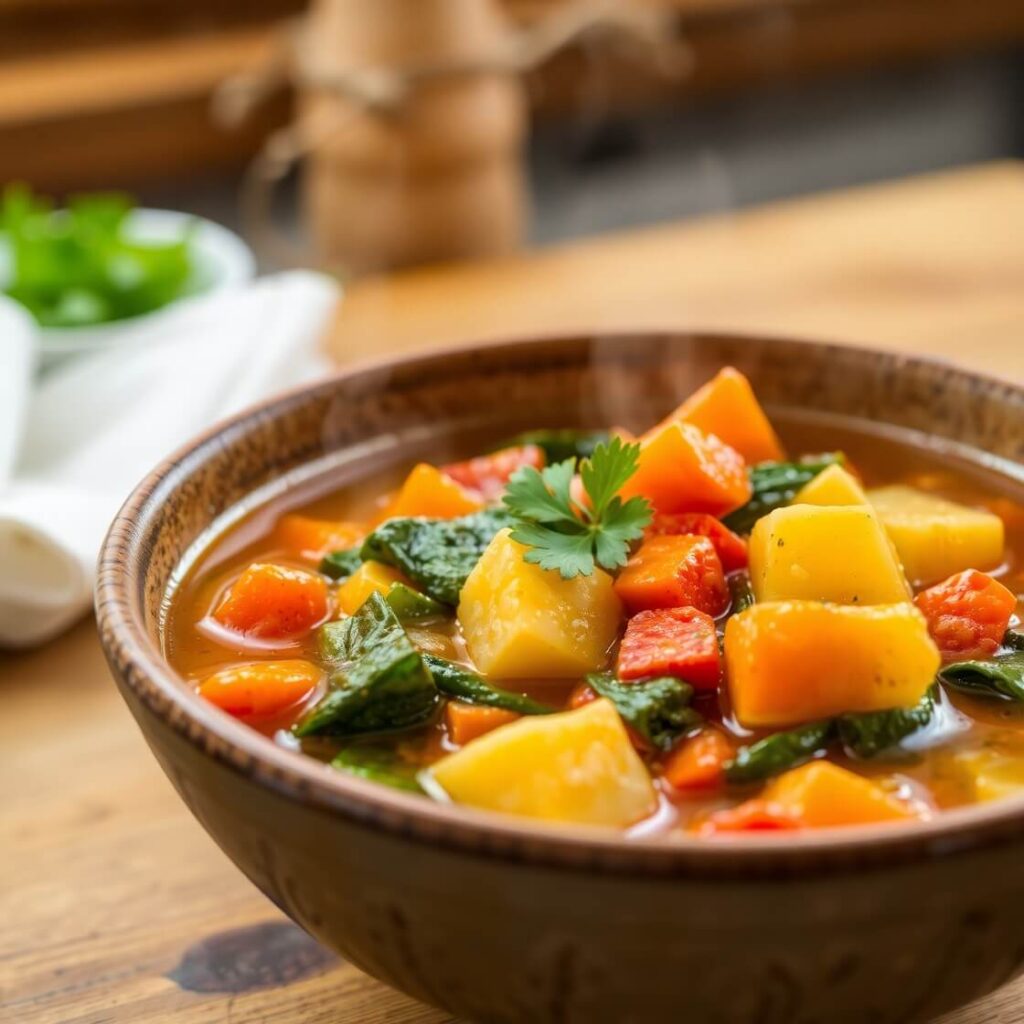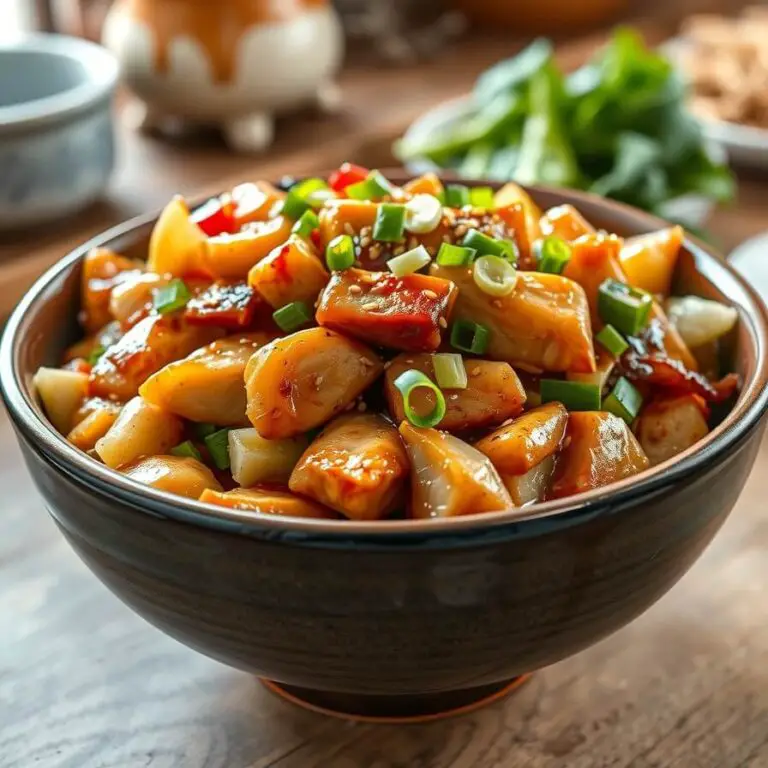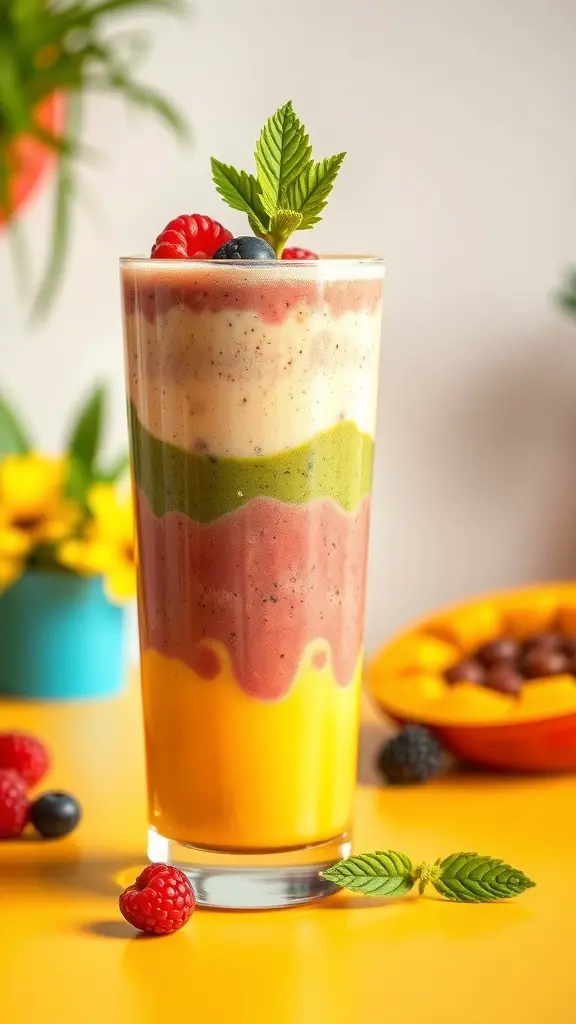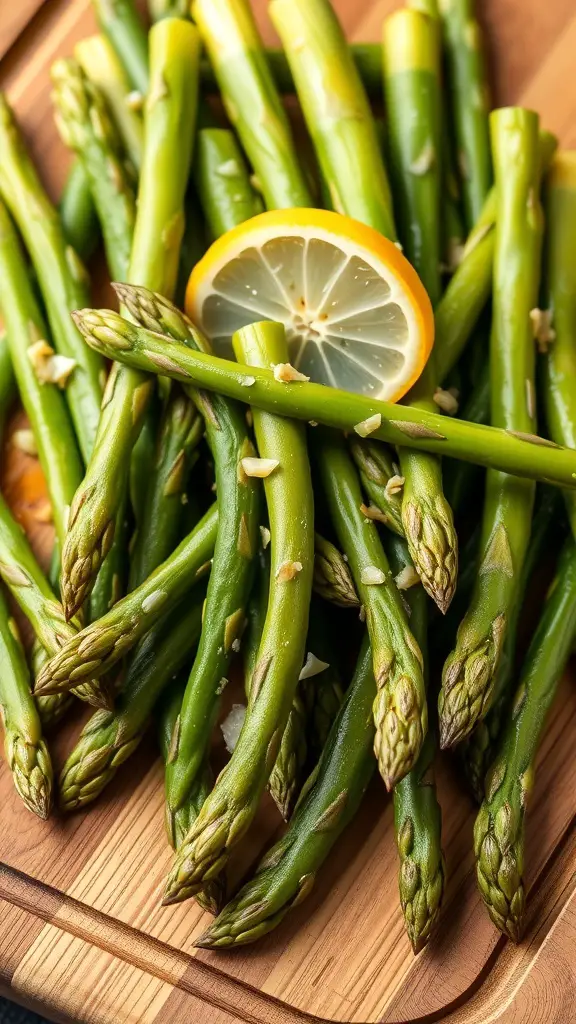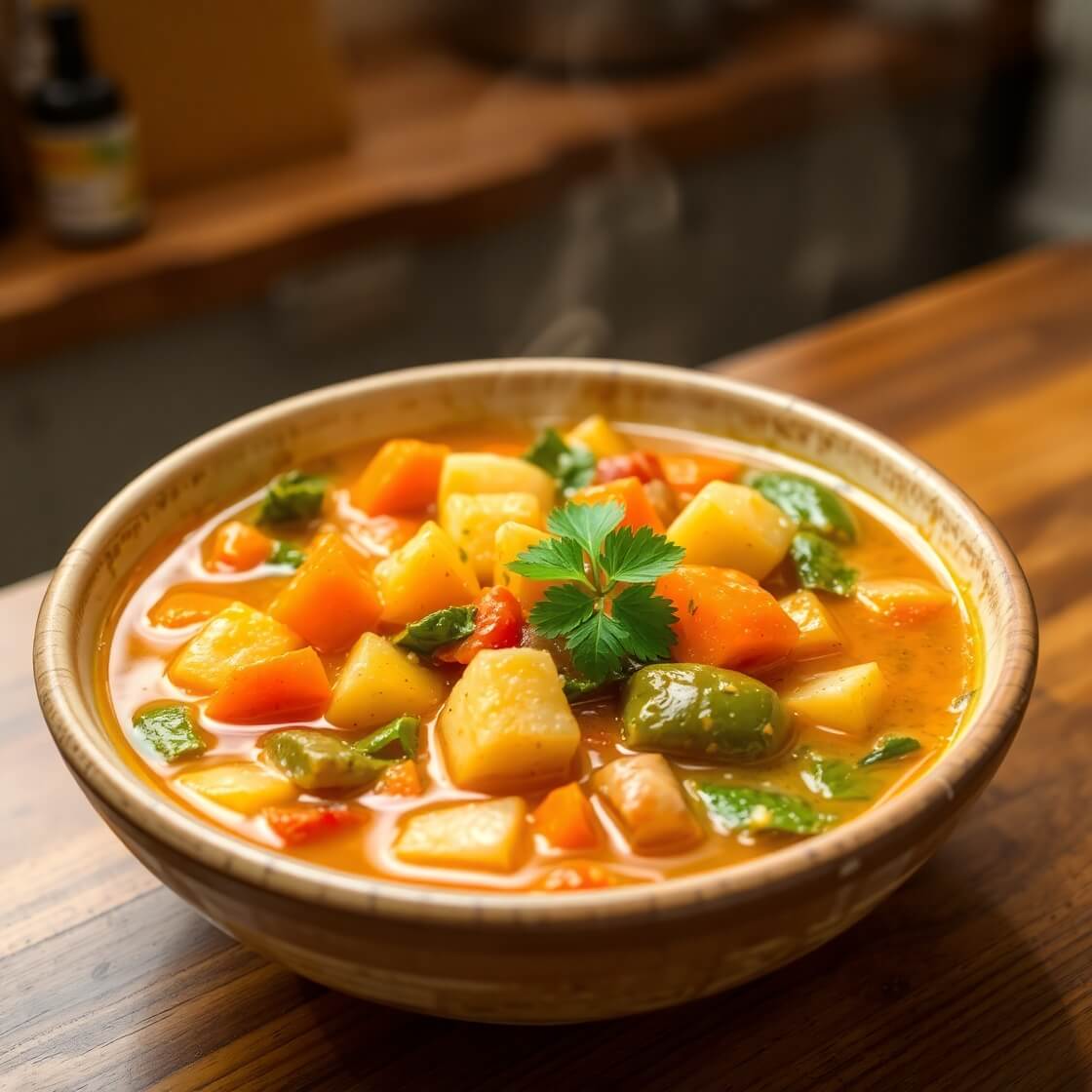
I’ve always had a soft spot for a warm, comforting vegetable stew, especially during chilly evenings when I crave something wholesome and hearty. This recipe is a beautiful medley of seasonal vegetables, simmered slowly to bring out their natural sweetness and flavors. I first made this stew one rainy afternoon when I had a basket of fresh vegetables in my kitchen, and the aroma of simmering herbs and spices instantly filled the home with warmth and coziness.
Vegetable stew isn’t just a meal—it’s a ritual of comfort. It’s the type of dish that makes you pause, breathe, and savor the moment. Whether you are looking for a nourishing family dinner or a satisfying lunch, this recipe is flexible, wholesome, and deeply satisfying. I promise, once you make this, it will become a staple in your kitchen rotation.
The beauty of this vegetable stew lies not just in its flavors but in its simplicity. It doesn’t require complicated techniques, yet it delivers a depth of flavor that feels gourmet. Every bite is a perfect balance of freshness, seasoning, and warmth—a hug in a bowl. Keep reading, and I’ll walk you through exactly how to recreate this comforting classic in your own kitchen.
Why I Love This Recipe
Vegetable stew is one of those timeless dishes that never go out of style. What I love most about it is its versatility and the way it brings comfort in every spoonful. You can make it hearty or light, depending on your mood or what you have on hand.
I often make this stew when I want something nutritious, satisfying, and wholesome without spending hours in the kitchen. What makes this recipe special is the combination of fresh vegetables with aromatic herbs that create a layered, flavorful broth. It’s not just about throwing vegetables together—it’s about coaxing the natural flavors out slowly, letting them mingle, and creating something extraordinary from simple ingredients.
Many people make vegetable stew for its health benefits. It’s loaded with vitamins, minerals, and fiber. And because it’s plant-based, it fits perfectly into a vegetarian or vegan lifestyle. Beyond the nutrition, it’s also incredibly comforting. There’s something about a hot bowl of stew that feels like a warm embrace on the inside, especially when shared with family or friends.
Every time I serve this stew, I notice the joy it brings. It’s a dish that feels indulgent yet nourishing. Whether it’s a cozy weeknight dinner or a weekend gathering, vegetable stew is always a crowd-pleaser. The rich aroma, the vibrant colors, and the satisfying flavors make it a dish I genuinely look forward to cooking again and again.
Ingredients for Vegetable Stew
The magic of this vegetable stew comes from the careful selection of ingredients. You’ll need a variety of fresh vegetables, aromatic herbs, and just a few pantry staples. Using fresh, seasonal vegetables will enhance the flavors, but don’t worry—you can adapt it to whatever you have at home.
- Vegetables: I like using a mix of carrots, potatoes, celery, bell peppers, zucchini, and tomatoes. They bring sweetness, texture, and color to the stew. You can also add leafy greens like kale or spinach for extra nutrition.
- Aromatics: Onion, garlic, and leeks form the flavor base. Sautéing these gently before adding the vegetables brings out their natural sweetness.
- Herbs and Spices: Fresh thyme, rosemary, bay leaves, and a pinch of smoked paprika elevate the stew. These herbs infuse it with warmth and depth.
- Liquids: Vegetable broth is ideal, but you can also use water with a splash of soy sauce or a touch of tomato paste for richness.
- Extras: A drizzle of olive oil, a splash of lemon juice at the end, and a sprinkle of freshly ground black pepper make a huge difference.
The key is balance. You want a stew that’s rich and flavorful but not overpowering. Choosing high-quality vegetables and herbs will make the flavors shine naturally.
How Much Time Will You Need
This vegetable stew is not a quick-fix meal, but the results are worth every minute. From prep to finish, you should plan for about 1 hour and 15 minutes.
- Preparation time: 20-25 minutes
- Cooking time: 50-55 minutes
The beauty of stew is that it simmers gently, allowing flavors to develop fully. While it’s cooking, your kitchen will fill with an irresistible aroma, and the vegetables will soften perfectly without losing their character.
How to Make This Vegetable Stew
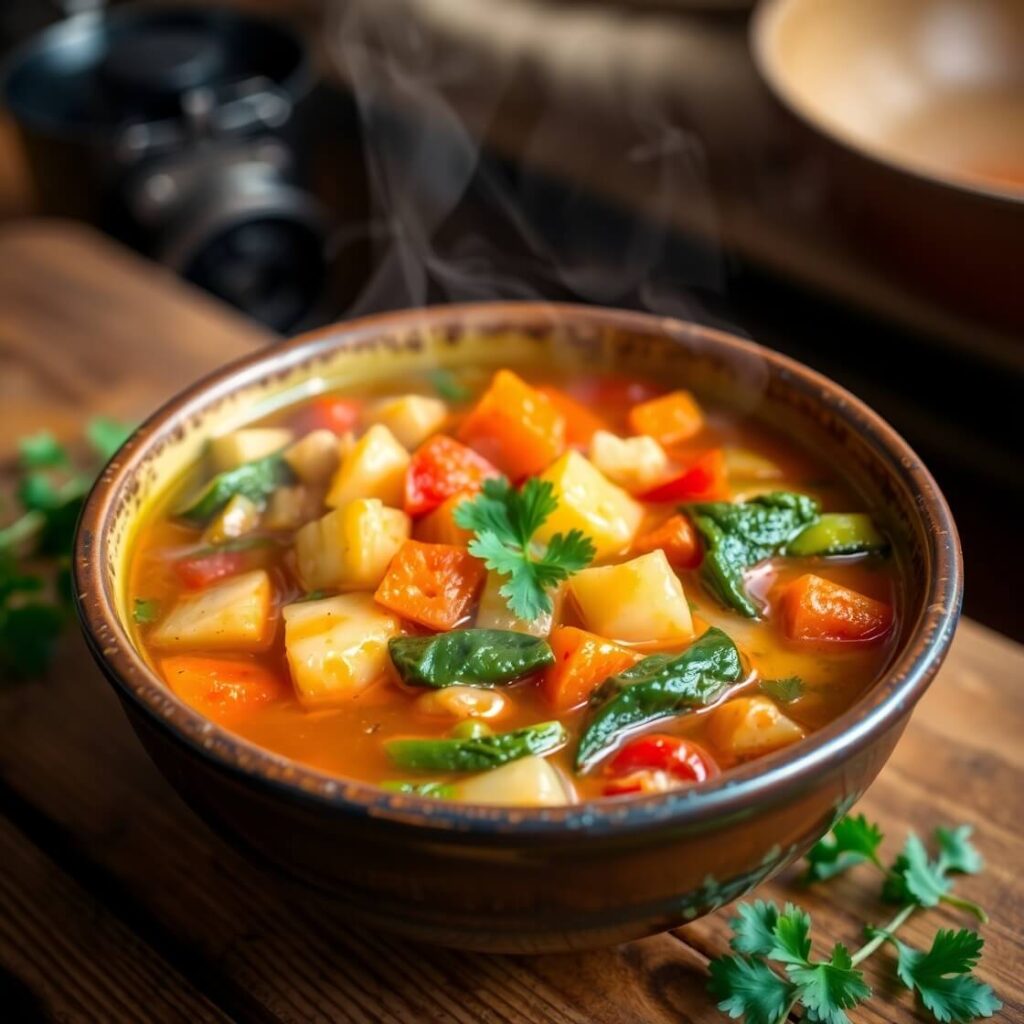
Here’s a detailed, step-by-step guide so you can recreate this stew perfectly. I’ve broken it down so that anyone, even beginners, can follow along.
Step – 1: Prepare your vegetables. Peel and chop carrots and potatoes into bite-sized pieces. Dice the bell peppers and zucchini. Chop onions, celery, and leeks finely. Mince garlic. Wash and roughly chop any leafy greens you’re using.
Step – 2: In a large, heavy-bottomed pot, heat 2 tablespoons of olive oil over medium heat. Add the onions, leeks, and celery. Sauté gently for 5-7 minutes until softened and fragrant. Stir in the garlic and cook for another 1 minute.
Step – 3: Add the carrots, potatoes, bell peppers, and zucchini. Stir to coat with the aromatics and oil. Cook for 5 minutes, letting the vegetables slightly caramelize. This step adds depth of flavor.
Step – 4: Pour in 4 cups of vegetable broth. Add bay leaves, thyme, rosemary, smoked paprika, salt, and pepper. Stir gently to combine. Increase the heat to bring the stew to a gentle boil.
Step – 5: Once boiling, reduce heat to low and cover the pot. Let it simmer for 30-35 minutes, stirring occasionally, until the vegetables are tender and the flavors meld together beautifully.
Step – 6: If you’re adding leafy greens, stir them in during the last 5 minutes of cooking. Add a splash of lemon juice for brightness and adjust seasoning with salt and pepper.
Step – 7: Serve hot in bowls, garnished with fresh herbs like parsley or a drizzle of olive oil. Enjoy the comforting aroma and flavors that have developed through slow cooking.
Substitutions
One of the best things about vegetable stew is how adaptable it is. If you don’t have certain vegetables, don’t worry.
- Potatoes: You can use sweet potatoes or turnips.
- Bell peppers: Substitute with squash or pumpkin for a slightly sweeter flavor.
- Leafy greens: Spinach, chard, or collard greens work beautifully.
- Broth: Chicken or beef broth can be used if you aren’t making it vegan.
Adding a splash of coconut milk near the end can create a creamy version, perfect for a twist on the classic.
Best Side Dish for Vegetable Stew
A bowl of vegetable stew can shine on its own, but pairing it with simple side dishes makes the meal even more delightful. My favorite pairings are:
- Crusty homemade bread for dipping into the rich broth
- Steamed rice to soak up all the flavorful juices
- A fresh, crisp green salad to add a contrasting texture
These sides complement the stew without overwhelming it, creating a balanced and satisfying meal.
Serving and Presentation Tips
Serving vegetable stew is not just about filling a bowl—it’s about creating an experience that feels inviting and comforting. When I serve this stew, I like to use deep, wide bowls so the colors of the vegetables shine. The contrast of bright carrots, green beans or kale, and red bell peppers makes the dish visually appealing and appetizing.
A little garnish goes a long way. Fresh herbs like parsley, thyme, or a sprinkle of chives add a pop of color and freshness. If you like a subtle richness, a drizzle of high-quality olive oil or a swirl of coconut cream on top instantly elevates the presentation. I often pair the stew with crusty bread on the side, arranged neatly on a wooden board or plate, which makes the meal feel cozy and thoughtfully prepared.
If you want to make it more family-style, serve the stew in a large, rustic pot in the center of the table with individual bowls and bread nearby. It encourages sharing and creates a warm, inviting vibe that everyone will love.
Tips and Tricks to Make This Recipe Even Better
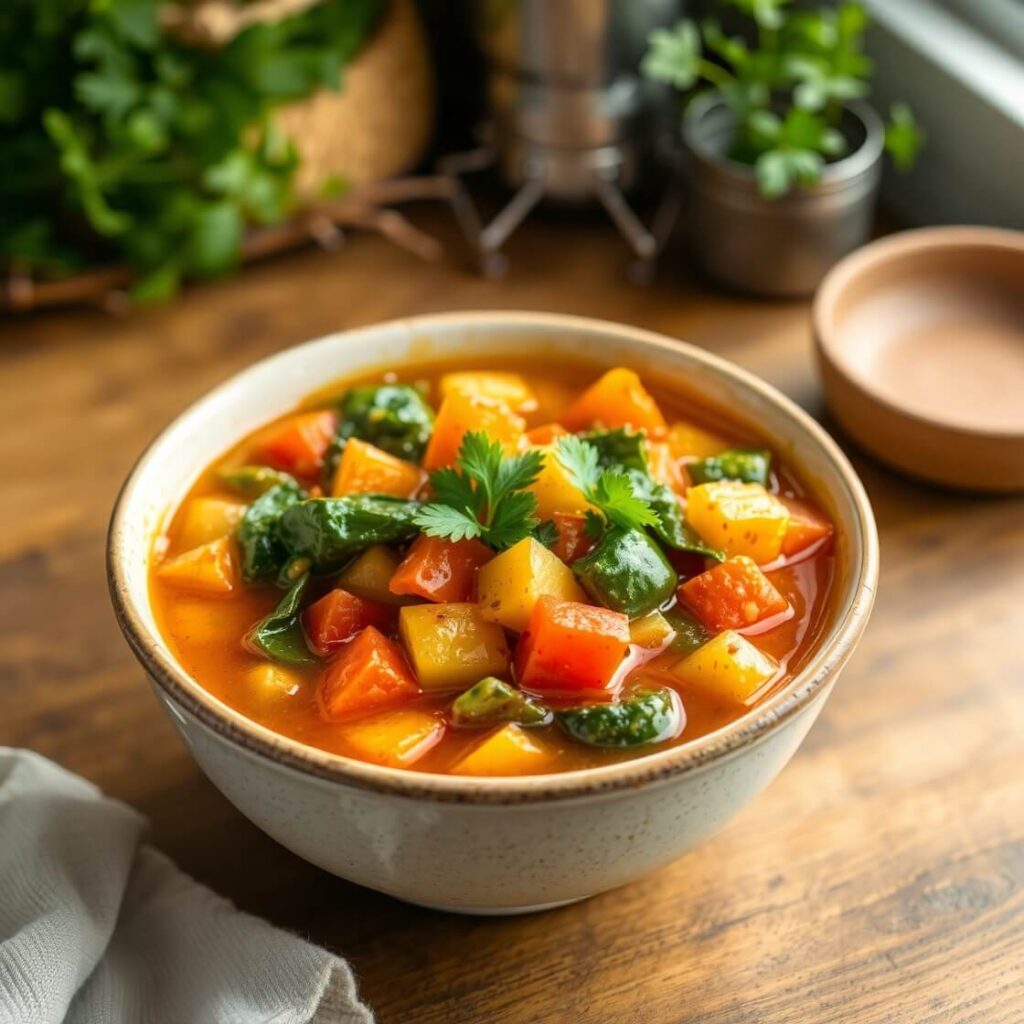
Over the years, I’ve learned a few tricks that make this vegetable stew extra flavorful and satisfying:
- Layer the flavors: Don’t just throw everything in at once. Sauté the aromatics first, then the vegetables, before adding the broth. This builds a depth of flavor that makes the stew taste richer.
- Use seasonal vegetables: They taste better and add more vibrant colors to your dish.
- Simmer gently: Avoid high heat once the broth is added. Slow simmering helps the flavors meld beautifully without turning the vegetables mushy.
- Finish with acidity: A splash of lemon juice, vinegar, or even a little white wine at the end brightens the stew and balances the flavors.
- Add texture: Consider topping with toasted nuts, seeds, or croutons for a satisfying crunch.
These small adjustments make a noticeable difference, taking a simple stew from good to unforgettable.
Common Mistakes to Avoid
Even a simple recipe like vegetable stew can be affected by a few common mistakes. Here’s what I always watch out for:
- Overcooking vegetables: While you want them tender, mushy vegetables can ruin the texture. Keep an eye on them and adjust cooking time if needed.
- Underseasoning: Vegetables can taste bland if not seasoned properly. Taste frequently and adjust salt, pepper, and herbs as needed.
- Skipping aromatics: Onion, garlic, and celery form the flavor base. Don’t skip them—they add depth to the broth.
- Adding leafy greens too early: They will overcook and become mushy. Add them in the last few minutes of cooking.
- Not tasting as you go: This is key to a balanced stew. Adjust seasonings gradually rather than waiting until the end.
By avoiding these pitfalls, your stew will turn out flavorful, balanced, and perfectly textured every time.
How to Store It
Vegetable stew stores beautifully, which makes it a great meal prep option.
- Refrigeration: Allow the stew to cool to room temperature, then store it in an airtight container for up to 4 days.
- Freezing: For longer storage, freeze the stew in airtight containers for up to 3 months. Make sure to leave a little space at the top for expansion.
- Reheating: Warm gently over medium-low heat on the stovetop, stirring occasionally. Avoid high heat to prevent the vegetables from breaking down too much.
I often make a big batch and enjoy it for several days—it actually tastes even better the next day as the flavors have had time to meld.
FAQ
Can I make this stew vegan?
Absolutely! This recipe is naturally vegan if you use vegetable broth and skip any animal-based additions. It’s flavorful and hearty without needing meat.
Can I use frozen vegetables?
Yes, frozen vegetables work well, especially when fresh ones aren’t available. Just adjust cooking time slightly since frozen vegetables may release more water.
Can I make it spicy?
Certainly! Adding a pinch of chili flakes, cayenne pepper, or a chopped fresh chili during cooking gives the stew a subtle kick.
Can I make it ahead of time?
Yes, in fact, vegetable stew often tastes even better the next day. Store in the refrigerator and reheat gently before serving.
Can I add grains or beans?
Definitely. Barley, quinoa, or lentils can be added to make the stew heartier and more filling. Add them early in the simmering process to cook through.

Vegetable Stew
- Total Time: 1 hour 20 minutes
- Yield: 6 1x
- Diet: Vegan
Description
Vegetable Stew is a comforting, hearty dish full of vibrant seasonal vegetables, aromatic herbs, and rich, savory broth. Perfect for chilly evenings or cozy family dinners, this stew delivers both nutrition and warmth in every bite. Simple yet flavorful, it’s a recipe that brings joy to the table while being incredibly flexible to suit your preferences or pantry. A touch of lemon juice at the end brightens the flavors, making each spoonful a satisfying blend of wholesome goodness.
Ingredients
- 2 tablespoons olive oil
- 1 large onion, finely chopped
- 2 cloves garlic, minced
- 2 celery stalks, chopped
- 2 carrots, diced
- 2 potatoes, diced
- 1 red bell pepper, diced
- 1 zucchini, chopped
- 4 cups vegetable broth
- 2 bay leaves
- 1 teaspoon dried thyme
- 1 teaspoon dried rosemary
- 1/2 teaspoon smoked paprika
- Salt and pepper to taste
- 2 cups chopped leafy greens (spinach, kale, or chard)
- 1 tablespoon lemon juice
- Fresh parsley for garnish
Instructions
- Heat olive oil in a large pot over medium heat. Sauté onion, garlic, and celery until softened.
- Add carrots, potatoes, bell pepper, and zucchini. Stir for 5 minutes.
- Pour in vegetable broth and add herbs, bay leaves, salt, and pepper. Bring to a boil.
- Reduce heat and simmer covered for 30-35 minutes until vegetables are tender.
- Stir in leafy greens and lemon juice in the last 5 minutes. Adjust seasoning.
- Serve hot, garnished with fresh parsley.
Notes
- Swap vegetables according to season or preference.
- Add coconut milk for a creamy variation.
- Serve with crusty bread, rice, or a fresh salad for a complete meal.
- Prep Time: 25 minutes
- Cook Time: 55 minutes
- Category: Main Dish
- Method: Simmering / Stovetop
- Cuisine: International / Home-style
Nutrition
- Serving Size: 6
- Calories: 180
- Sugar: 8g
- Sodium: 400mg
- Fat: 5g
- Saturated Fat: 1g
- Unsaturated Fat: 4g
- Trans Fat: 0g
- Carbohydrates: 30g
- Fiber: 7g
- Protein: 5g
- Cholesterol: 0mg

